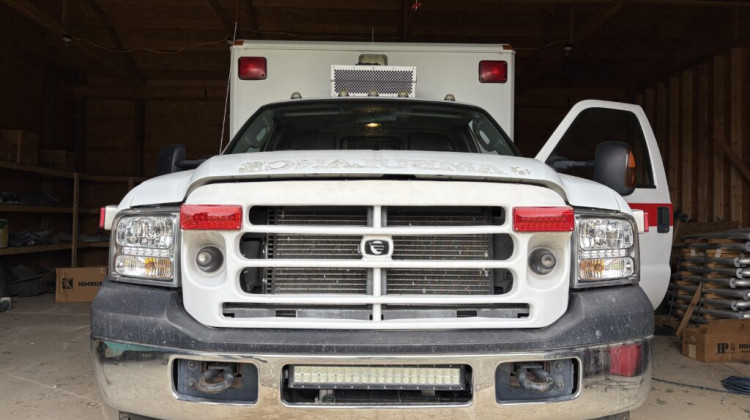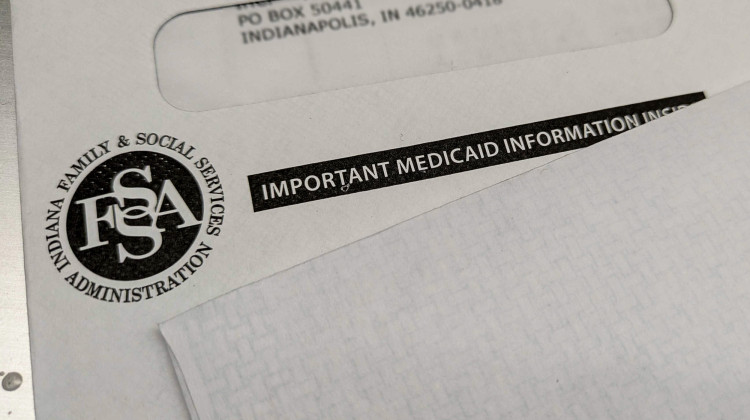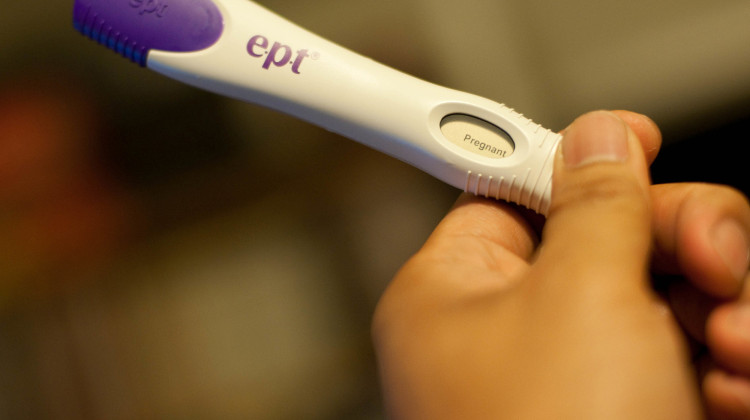
Sickle cell disease is a genetic blood disorder. It could affect most of the bodys organs including the spleen the organ responsible for fighting germs in the blood which is why children like Calieb need the daily prophylactic penicillin doses.
Farah Yousry / Side Effects Public MediaMary Warlo has been extremely worried lately.
Her baby Calieb, who is six months old, has sickle cell disease. In early December he went for a few days without liquid penicillin, a medication that he – and thousands of other children in the U.S. – rely on to prevent potentially life threatening infections.
Warlo couldn’t easily find a pharmacy in Indianapolis that had the medicine in stock. She and her husband frantically drove around for hours, stopping at five different pharmacies before they were able to get their prescription filled.
“It was extremely stressful and I am worried about what will happen the next time we need to fill his prescription two weeks from now,” she said.
Pediatric sickle cell disease specialists say they are alarmed by signs that the stock of liquid penicillin is dwindling in some places. They say children’s lives depend on this medication, and a penicillin shortage could spell disaster.
“I'm most worried that all of the work that we've done over the decades to ensure that our infants and children with sickle cell disease can live long and healthy lives will be compromised, because of them not being able to access… a basic medication,” said Dr. Seethal Jacob, a pediatric hematologist who treats sickle cell disease at Riley Children’s Hospital in Indianapolis.
Every year, 2,000 babies are born in the U.S. with sickle cell disease, a complex genetic disorder that affects the blood. The vast majority of sickle cell patients are Black.
As recently as the early ‘80s, nearly 1 in 3 children with sickle cell disease would die before their fifth birthday. Then, a landmark clinical trial found that a simple intervention could slash rates of life-threatening bacterial infections by more than 84 percent. The intervention involved two doses of preventative penicillin, administered daily between 2 months and at least 5 years of age.
Thanks to the widespread use of penicillin — and mandatory newborn screening for sickle cell disease — the death rate for children with sickle cell disease has plummeted over the past several decades. Today, more than 95 percent of children with sickle cell disease born will reach their 18th birthday.
Sickle cell disease weakens the immune system of children who have it, which makes a bacterial infection extremely risky.
Jacob is worried that more of her patients will end up in the hospital with serious bacterial infections and said that she is “significantly concerned that some of them may become so ill that they would pass from that infection as well, or its associated complications.”
What’s driving the recent shortage of antibiotics
The U.S. Food and Drug Administration tracks drug shortages and has not indicated that there is shortage of penicillin in the U.S.
But some hospitals like Riley Children’s in Indiana — and also St. Louis Children’s Hospital in Missouri — notified providers in early December that their liquid penicillin stock is running low, advising them to look for other alternatives.
Warlo said her doctor told her that if she can’t get liquid penicillin for her son Calieb, they may have to switch him to penicillin tablets. Warlo would need to crush the tablets and put them in his feedings.
One alternative to penicillin for children with sickle cell disease is an antibiotic called amoxicillin. Dr. Monica Hulbert, a pediatric sickle cell specialist at St. Louis Children’s Hospital, said she prescribed it to one of her patients the week of Dec. 1, but they were unable to find it in stock because of an ongoing nationwide shortage of amoxicillin.
Hulbert said the penicillin shortage is likely to push providers to prescribe alternative antibiotics with a broader range of coverage than penicillin, which can be a lot more expensive for patients. Some alternative antibiotics may also require prior authorization from insurance — a process that could take anywhere from 48 hours to a few weeks, Hulbert said, leaving children with sickle cell vulnerable to potentially life-threatening infections.
Hulbert also worries that as shortages for some antibiotics persist, there could be a ripple effect.
“The trick is that when one thing is unavailable, then everybody switches to the next thing. And then, demand may exceed supply on that too,” Hulbert said.
‘We cannot let this happen’
Antibiotic shortages in the U.S. are common, said Erin Fox, a senior pharmacy director at the University of Utah.
Fox has been tracking antibiotic shortages since 2001 and has found that antibiotics are always present among the top five drugs in short supply every year — and that could be for several reasons.
“These are older drugs, they're generic drugs, they are low-cost drugs. And so because of those characteristics, there's actually not a lot of incentive for manufacturers to have any extra on hand or any kind of backup supplies,” Fox said.
During the current shortage some manufacturers said they’ve been hit by labor shortages, Fox said. She’s also been hearing from more manufacturers who say that they've been holding their end of the contract, producing the amount of antibiotics they have been asked to produce.
But it seems that this year, that’s not enough, said Michael Ganio, senior director of pharmacy practice and quality at the American Society of Health-System Pharmacists.
Ganio said the current shortage doesn’t appear to be due to manufacturing hiccups or quality issues. It’s more likely a shortage driven by a sharp increase in demand over the past several weeks.
The country is dealing with a surge in infectious diseases “after a period of latency due to COVID-related mitigations like masking, remote work and schooling and social distancing,” he said.
Ganio is worried that the current shortage might have ripple effects — a shortage of one drug can fuel the shortage of alternatives for that drug.
“This is unusual, in that we're seeing the second and third choices affected,” Ganio said.
To resolve the shortages, manufacturers will need to ramp up production to stock up pharmacy shelves, he said. He’s hopeful that at least some manufacturers will be able to quickly do that, thanks to new technologies.
Dr. Kerry Morrone at the Children's Hospital at Montefiore in New York said she’s not heard from her patients or her hospital pharmacy of penicillin shortages yet. But she’s heard of shortages from her peers in other states, and that has alarmed her.
As things stand, the amoxicillin shortage is affecting sickle cell patients when they end up with a common complication called acute chest syndrome. The idea that penicillin, too, could possibly face a dire nationwide shortage terrifies her.
“We cannot let this happen. I'm dead serious,” Morrone said. “If there’s a short supply [of penicillin], I don't know what I'm going to do.”
Sickle cell disease patients already face a litany of social and economic challenges everyday that makes it hard to get basic care. Being hit with a widespread penicillin would have huge ramifications, said Morrone.
“Children will die,” she said.
This story comes from a reporting collaboration that includes the Indianapolis Recorder and Side Effects Public Media — a public health news initiative based at WFYI. Contact Farah at fyousry@wfyi.org. Follow on Twitter: @Farah_Yousrym.
 DONATE
DONATE






 Support WFYI. We can't do it without you.
Support WFYI. We can't do it without you.